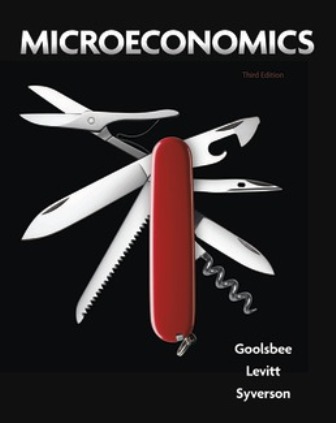Test Bank for Microeconomics, 3rd Edition, Austan Goolsbee Steven Levitt Chad Syverson
$35.00 Original price was: $35.00.$26.50Current price is: $26.50.
Test Bank for Microeconomics, 3rd Edition, Austan Goolsbee, Steven Levitt, Chad Syverson
This is completed downloadable of Test Bank for Microeconomics, 3rd Edition, Austan Goolsbee, Steven Levitt, Chad Syverson

Product Details:
- ISBN-10 : 1319105564
- ISBN-13 : 978-1319105563
- Author: Austan Goolsbee, Steven Levitt, Chad Syverson
Like no other text for the intermediate microeconomics course, Goolsbee, Levitt, and Syverson’s Microeconomics bridges the gap between today’s theory and practice. A strong empirical dimension tests theory and successfully applies it. With carefully crafted features and vivid examples, Goolsbee, Levitt, and Syverson’s text helps answer two critical questions students ask, “Do people and firms really act as theory suggests” and “How can someone use microeconomics in a practical way?”
The authors teach in economics departments and business schools and are active empirical microeconomics researchers. Their grounding in different areas of empirical research allows them to present the evidence developed in the last 20 years that has tested and refined the fundamental theories. Their teaching and professional experiences are reflected in an outstanding presentation of theories and applications.
Table of Content:
- Part 1 Basic Concepts
- Chapter 1 Adventures in Microeconomics
- 1.1 Microeconomics (and What It Can Teach Us about Rosa and Lauren)
- Learning the Tools of Microeconomics
- Using the Tools of Microeconomics
- 1.2 This Book (and How Rosa and Lauren Would See It)
- Consumers’ and Producers’ Decisions
- Market Supply
- Beyond the Basics
- Focus on Data
- Let the Fun Begin!
- Summary
- Review Questions
- Chapter 2 Supply and Demand
- 2.1 Markets and Models
- What Is a Market?
- Key Assumptions of the Supply and Demand Model
- 2.2 Demand
- Factors That Influence Demand
- Demand Curves
- Shifts in Demand Curves
- 2.3 Supply
- Factors That Influence Supply
- Supply Curves
- Shifts in the Supply Curve
- 2.4 Market Equilibrium
- The Mathematics of Equilibrium
- Why Markets Move toward Equilibrium
- The Effects of Demand Shifts
- The Effects of Supply Shifts
- Summary of Effects
- What Determines the Size of Price and Quantity Changes?
- Changes in Market Equilibrium When Both Curves Shift
- 2.5 Elasticity
- Slope and Elasticity Are Not the Same
- The Price Elasticities of Demand and Supply
- Price Elasticities and Price Responsiveness
- Elasticities and Linear Demand and Supply Curves
- Perfectly Inelastic and Perfectly Elastic Demand and Supply
- The Factors in “Everything Else”
- 2.6 Conclusion
- Summary
- Review Questions
- Problems
- Chapter 3 Using Supply and Demand to Analyze Markets
- 3.1 Consumer and Producer Surplus: Who Benefits in a Market?
- Consumer Surplus
- Producer Surplus
- The Distribution of Gains and Losses from Changes in Market Conditions
- 3.2 Price Regulations
- Price Ceilings
- Price Floors
- 3.3 Quantity Regulations
- Quotas
- 3.4 Taxes
- Tax Effects on Markets
- Why Taxes Create a Deadweight Loss
- Why a Big Tax Is Much Worse Than a Small Tax
- The Incidence of Taxation: The Payer Doesn’t Matter
- 3.5 Subsidies
- 3.6 Conclusion
- Summary
- Review Questions
- Problems
- Part 2 Consumption and Production
- Chapter 4 Consumer Behavior
- 4.1 The Consumer’s Preferences and the Concept of Utility
- Assumptions about Consumer Preferences
- The Concept of Utility
- Marginal Utility
- Utility and Comparisons
- 4.2 Indifference Curves
- Characteristics of Indifference Curves
- The Marginal Rate of Substitution
- The Marginal Rate of Substitution and Marginal Utility
- The Steepness of Indifference Curves
- The Curvature of Indifference Curves: Substitutes and Complements
- 4.3 The Consumer’s Income and the Budget Constraint
- The Slope of the Budget Constraint
- Factors That Affect the Budget Constraint
- Nonstandard Budget Constraints
- 4.4 Combining Utility, Income, and Prices: What Will the Consumer Consume?
- Solving the Consumer’s Optimization Problem
- Implications of Utility Maximization
- A Special Case: Corner Solutions
- 4.5 Conclusion
- Summary
- Review Questions
- Problems
- Chapter 4 Appendix: The Calculus of Utility Maximization and Expenditure Minimization
- Consumer’s Optimization Problem
- The Marginal Rate of Substitution and Marginal Utility
- Utility Maximization
- Utility Maximization Using the Lagrangian
- Expenditure Minimization
- Problems
- Chapter 5 Individual and Market Demand
- 5.1 How Income Changes Affect an Individual’s Consumption Choices
- Normal and Inferior Goods
- Income Elasticities and Types of Goods
- The Income Expansion Path
- The Engel Curve
- 5.2 How Price Changes Affect Consumption Choices
- Deriving a Demand Curve
- Shifts in the Demand Curve
- 5.3 Consumer Responses to Price Changes: Substitution and Income Effects
- Isolating the Substitution Effect
- Isolating the Income Effect
- The Total Effects
- What Determines the Size of the Substitution and Income Effects?
- An Example of the Income and Substitution Effects with an Inferior Good
- Giffen Goods
- 5.4 The Impact of Changes in Another Good’s Price: Substitutes and Complements
- A Change in the Price of a Substitute Good
- Indifference Curve Shapes, Revisited
- 5.5 Combining Individual Demand Curves to Obtain the Market Demand Curve
- The Market Demand Curve
- Using Algebra to Move from Individual to Market Demand
- 5.6 Conclusion
- Summary
- Review Questions
- Problems
- Chapter 5 Appendix: The Calculus of Income and Substitution Effects
- Problems
- Chapter 6 Producer Behavior
- 6.1 The Basics of Production
- Simplifying Assumptions about Firms’ Production Behavior
- Production Functions
- 6.2 Production in the Short Run
- Marginal Product
- Average Product
- 6.3 Production in the Long Run
- The Long-Run Production Function
- 6.4 The Firm’s Cost-Minimization Problem
- Isoquants
- Isocost Lines
- Identifying Minimum Cost: Combining Isoquants and Isocost Lines
- Input Price Changes
- 6.5 Returns to Scale
- Factors Affecting Returns to Scale
- 6.6 Technological Change
- 6.7 The Firm’s Expansion Path and Total Cost Curve
- 6.8 Conclusion
- Summary
- Review Questions
- Problems
- Chapter 6 Appendix: The Calculus of Cost Minimization
- Marginal Products of Inputs and Marginal Rate of Technical Substitution
- Cost Minimization Using Calculus
- The Firm’s Expansion Path
- Problems
- Chapter 7 Costs
- 7.1 Costs That Matter for Decision Making: Opportunity Costs
- 7.2 Costs That Do Not Matter for Decision Making: Sunk Costs
- Sunk Costs and Decisions
- 7.3 Costs and Cost Curves
- Flexibility and Fixed versus Variable Costs
- Time Horizon
- Other Factors
- Deriving Cost Curves
- 7.4 Average and Marginal Costs
- Average Cost Measures
- Marginal Cost
- Relationships between Average and Marginal Costs
- 7.5 Short-Run and Long-Run Cost Curves
- Short-Run Production and Total Cost Curves
- Short-Run versus Long-Run Average Total Cost Curves
- Short-Run versus Long-Run Marginal Cost Curves
- 7.6 Economies in the Production Process
- Economies of Scale
- Economies of Scale versus Returns to Scale
- Economies of Scope
- Where Economies of Scope Come From
- 7.7 Conclusion
- Summary
- Review Questions
- Problems
- Chapter 7 Appendix: The Calculus of a Firm’s Cost Structure
- Problems
- Part 3 Markets and Prices
- Chapter 8 Supply in a Competitive Market
- 8.1 Market Structures and Perfect Competition in the Short Run
- Perfect Competition
- Why Perfectly Competitive Markets Are Important to Study, Even if Rare in Real Life
- The Demand Curve as Seen by a Price Taker
- 8.2 Profit Maximization in a Perfectly Competitive Market
- Total Revenue, Total Cost, and Profit Maximization
- How a Perfectly Competitive Firm Maximizes Profit
- Measuring a Firm’s Profit
- If Profit Is Negative, Should a Firm Shut Down?
- 8.3 Perfect Competition in the Short Run
- A Firm’s Short-Run Supply Curve in a Perfectly Competitive Market
- The Short-Run Supply Curve for a Perfectly Competitive Industry
- The Short-Run Supply Curve: A Graphical Approach
- Producer Surplus for a Competitive Firm in the Short Run
- Producer Surplus and Profit
- Producer Surplus for a Competitive Industry
- 8.4 Perfectly Competitive Industries in the Long Run
- Entry
- Exit
- Graphing the Industry Long-Run Supply Curve
- Adjustments between Long-Run Equilibria
- A Demand Increase
- A Cost Decrease
- Long-Run Supply in Constant-, Increasing-, and Decreasing-Cost Industries
- 8.5 Producer Surplus, Economic Rents, and Economic Profits
- Cost Differences and Economic Rent in Perfect Competition
- Economic Profit Is Not the Same as Economic Rent
- 8.6 Conclusion
- Summary
- Review Questions
- Problems
- Chapter 9 Market Power and Monopoly
- 9.1 Sources of Market Power: Barriers to Entry
- Extreme Scale Economies: Natural Monopoly
- Switching Costs
- Product Differentiation
- Absolute Cost Advantages or Control of Key Inputs
- Government Regulation
- Where There’s a Will (and Producer Surplus), There’s a Way
- 9.2 Market Power and Marginal Revenue
- Market Power and Monopoly
- Marginal Revenue
- Why Does the Price Have to Fall for Every Unit the Firm Sells?
- Marginal Revenue: A Graphical Approach
- Marginal Revenue: A Mathematical Approach
- 9.3 Profit Maximization for a Firm with Market Power
- How to Maximize Profit
- Profit Maximization with Market Power: A Graphical Approach
- Profit Maximization with Market Power: A Mathematical Approach
- A Markup Formula for Companies with Market Power: The Lerner Index
- Measuring the Lerner Index
- The Supply Relationship for a Firm with Market Power
- 9.4 How a Firm with Market Power Reacts to Market Changes
- Response to a Change in Marginal Cost
- Response to a Change in Demand
- The Big Difference: Changing the Price Sensitivity of Customers
- 9.5 The Winners and Losers from Market Power
- Consumer and Producer Surplus under Market Power
- Consumer and Producer Surplus under Perfect Competition
- The Deadweight Loss of Market Power
- Differences in Producer Surplus for Different Firms
- 9.6 Governments and Market Power: Regulation, Antitrust, and Innovation
- Direct Price Regulation
- Antitrust
- Promoting Monopoly: Patents, Licenses, and Copyrights
- 9.7 Conclusion
- Summary
- Review Questions
- Problems
- Chapter 9 Appendix: The Calculus of Profit Maximization
- The Profit-Maximizing Condition
- Marginal Revenue
- Chapter 10 Pricing Strategies for Firms with Market Power
- 10.1 The Basics of Pricing Strategy
- When a Firm Can Use a Pricing Strategy with Different Prices
- 10.2 Direct Price Discrimination I: Perfect (First-Degree) Price Discrimination
- Examples of Perfect Price Discrimination
- 10.3 Direct Price Discrimination II: Segmenting (Third-Degree Price Discrimination)
- The Benefits of Segmenting: A Graphical Approach
- The Benefits of Segmenting: A Mathematical Approach
- How Much Should Each Segment Be Charged?
- Ways to Directly Segment Customers
- By Customer Characteristics
- By Past Purchase Behavior
- By Location
- Over Time
- 10.4 Indirect (Second-Degree) Price Discrimination
- Indirect Price Discrimination through Quantity Discounts
- Incentive Compatibility
- Indirect Price Discrimination through Versioning
- Versioning and Price-Cost Margins
- 10.5 Bundling
- Mixed Bundling
- 10.6 Advanced Pricing Strategies
- Block Pricing
- Two-Part Tariffs
- 10.7 Conclusion
- Summary
- Review Questions
- Problems
- Chapter 11 Imperfect Competition
- 11.1 What Does Equilibrium Mean in an Oligopoly?
- 11.2 Oligopoly with Identical Goods: Collusion and Cartels
- The Instability of Collusion and Cartels
- What Makes Collusion Easier?
- 11.3 Oligopoly with Identical Goods: Bertrand Competition
- Setting Up the Bertrand Model
- Nash Equilibrium of a Bertrand Oligopoly
- 11.4 Oligopoly with Identical Goods: Cournot Competition
- Setting Up the Cournot Model
- Equilibrium in a Cournot Oligopoly
- Comparing Cournot to Collusion and to Bertrand Oligopoly
- What Happens if There Are More Than Two Firms in a Cournot Oligopoly?
- Cournot versus Bertrand: Extensions
- 11.5 Oligopoly with Identical Goods but with a First-Mover: Stackelberg Competition
- Stackelberg Competition and the First-Mover Advantage
- 11.6 Oligopoly with Differentiated Goods: Bertrand Competition
- Equilibrium in a Differentiated-Products Bertrand Market
- 11.7 Monopolistic Competition
- Equilibrium in Monopolistically Competitive Markets
- 11.8 Conclusion
- Summary
- Review Questions
- Problems
- Chapter 12 Game Theory
- 12.1 What Is a Game?
- Dominant and Dominated Strategies
- 12.2 Nash Equilibrium in Simultaneous Games
- Multiple Equilibria
- Mixed Strategies
- What If My Opponent Is an Idiot? The Maximin Strategy
- 12.3 Repeated Games
- Finitely Repeated Games
- Infinitely Repeated Games
- 12.4 Sequential Games
- Another Sequential Game
- 12.5 Strategic Moves, Credibility, and Commitment
- Side Payments
- Commitment
- Entry Deterrence: Credibility Applied
- Reputation
- 12.6 Conclusion
- Summary
- Review Questions
- Problems
- Chapter 13 Factor Markets
- 13.1 Demand in a Perfectly Competitive Factor Market
- The Firm’s Demand for Labor
- The Firm’s Labor Demand: A Graphical Approach
- Shifts in the Firm’s Labor Demand Curve
- Market Labor Demand Curve
- 13.2 Supply in a Perfectly Competitive Factor Market
- Work, Leisure, and Individual Labor Supply
- Income and Substitution Effects of a Change in Wages
- Backward-Bending Supply Curves
- Market-Level Labor Supply
- 13.3 Labor Market Equilibrium
- 13.4 The Labor Market in the Long Run
- 13.5 Other Perfectly Competitive Factor Markets
- Demand in Other Factor Markets
- Supply in Other Factor Markets
- 13.6 Imperfectly Competitive Factor Markets: Monopsony, a Monopoly in Factor Demand
- Marginal Expenditure
- Factor Demand with Monopsony Power
- Equilibrium for a Monopsony
- 13.7 Imperfectly Competitive Factor Markets: Monopoly in Factor Supply
- Labor Markets and Unions
- 13.8 Bilateral Monopoly
- 13.9 Conclusion
- Summary
- Review Questions
- Problems
- Part 4 Beyond the Basics
- Chapter 14 Investment, Time, and Insurance
- 14.1 Present Discounted Value Analysis
- Interest Rates
- Present Discounted Value
- 14.2 Evaluating Investment Choices
- Net Present Value
- The Key Role of Interest Rates in Determining NPV
- NPVs versus Payback Periods
- 14.3 The Correct Interest Rate to Use, and Capital Markets
- Nominal versus Real Interest Rates
- Using the Correct Rate
- 14.4 Evaluating Risky Investments
- NPV with Uncertainty: Expected Value
- Risk and the Option Value of Waiting
- 14.5 Uncertainty, Risk, and Insurance
- Expected Income, Expected Utility, and the Risk Premium
- Insurance Markets
- The Degree of Risk Aversion
- 14.6 Conclusion
- Summary
- Review Questions
- Problems
- Chapter 15 General Equilibrium
- 15.1 General Equilibrium Effects in Action
- An Overview of General Equilibrium Effects
- Quantitative General Equilibrium: The Corn Example with Demand-Side Market Links
- Quantitative General Equilibrium: The Corn Example with Supply-Side Market Links
- 15.2 General Equilibrium: Equity and Efficiency
- Standards for Measuring Market Performance: Social Welfare Functions
- Standards for Measuring Market Performance: Pareto Efficiency
- Looking for Pareto Efficiency in Markets
- Efficiency in Markets — Three Requirements
- 15.3 Efficiency in Markets: Exchange Efficiency
- The Edgeworth Box
- Gains from Trade in the Edgeworth Box
- 15.4 Efficiency in Markets: Input Efficiency
- The Production Possibilities Frontier
- 15.5 Efficiency in Markets: Output Efficiency
- The Marginal Rate of Transformation
- 15.6 Markets, Efficiency, and the Welfare Theorems
- 15.7 Conclusion
- Summary
- Review Questions
- Problems
- Chapter 16 Asymmetric Information
- 16.1 The Lemons Problem and Adverse Selection
- Observable Quality
- Unobservable Quality
- Adverse Selection
- Other Examples of the Lemons Problem
- Mechanisms That Mitigate Lemons Problems
- Adverse Selection When the Buyer Has More Information: Insurance Markets
- Mitigating Adverse Selection in Insurance
- 16.2 Moral Hazard
- An Extreme Example of Moral Hazard
- Examples of Moral Hazard in Insurance Markets
- Moral Hazard Outside Insurance Markets
- Lessening Moral Hazard
- 16.3 Asymmetric Information in Principal–Agent Relationships
- Principal–Agent and Moral Hazard: An Example
- More General Principal–Agent Relationships
- 16.4 Signaling to Solve Asymmetric Information Problems
- The Classic Signaling Example: Education
- Other Signals
- 16.5 Conclusion
- Summary
- Review Questions
- Problems
- Chapter 17 Externalities and Public Goods
- 17.1 Externalities
- Why Things Go Wrong: The Economic Inefficiencies from Externalities
- Negative Externalities: Too Much of a Bad Thing
- Positive Externalities: Not Enough of a Good Thing
- 17.2 Correcting Externalities
- The Efficient Level of Pollution
- Using Prices to Correct Externalities
- Pigouvian Taxes
- Pigouvian Subsidy
- Quantity Mechanisms to Correct Externalities
- Quotas
- Government Provision of a Good
- Price-Based versus Quantity-Based Interventions with Uncertainty
- A Market-Oriented Approach to Reducing Externalities: Tradable Permits Markets
- 17.3 The Coase Theorem: Free Markets Addressing Externalities on Their Own
- The Coase Theorem and Tradable Permits Markets
- 17.4 Public Goods
- The Optimal Level of Public Goods
- Solving the Free-Rider Problem
- The Tragedy of the Commons
- Remedies for the Tragedy of the Commons
- 17.5 Conclusion
- Summary
- Review Questions
- Problems
- Chapter 18 Behavioral and Experimental Economics
- 18.1 When Human Beings Fail to Act the Way Economic Models Predict
- Systematic Bias 1: Overconfidence
- Systematic Bias 2: Self-Control Problems and Hyperbolic Discounting
- Systematic Bias 3: Falling Prey to Framing
- Systematic Bias 4: Paying Attention to Sunk Costs
- Systematic Bias 5: Fairness and Generosity
- 18.2 Does Behavioral Economics Mean Everything We’ve Learned Is Wrong?
- 18.3 Testing Economic Theories with Data: Experimental Economics
- Lab Experiments
- Natural Experiments and Field Experiments
- 18.4 Conclusions and the Future of Microeconomics
- Summary
- Review Questions
- Problems
- Math Review Appendix
- Solutions to Review Questions
- Solutions to Select End-of-Chapter Problems
- Glossary
- References
- Notes
- Index
- Back Cover
People Also Search:
microeconomics
microeconomics 3rd edition
microeconomics 3rd edition testbank download pdf
microeconomics 3rd edition download scribd
microeconomics 3rd edition goolsbee levitt syverson











